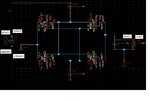vijith133
Member level 1
hi ,
i am designing a cc-rectifier with the help of cadence spectre, but am confused how to calculate the power conversion efficiency(PCE), can anyone help me with this issue, the output power is (Vdc)^2/Rout but how would i calculate the input power?
note : its a floating input
thank you
i am designing a cc-rectifier with the help of cadence spectre, but am confused how to calculate the power conversion efficiency(PCE), can anyone help me with this issue, the output power is (Vdc)^2/Rout but how would i calculate the input power?
note : its a floating input
thank you

